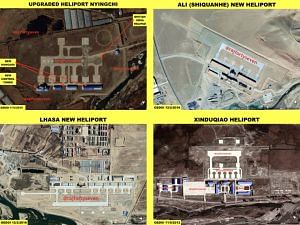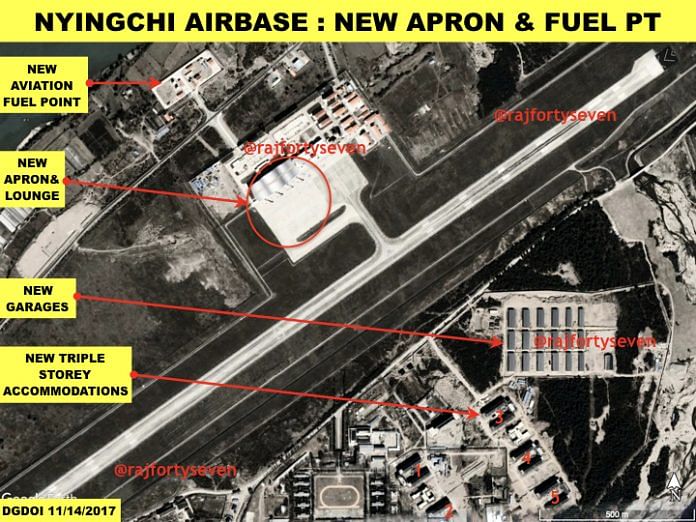Dual-use airports see 2-4 fold traffic increase; fighter jets and early warning aircraft deployed in the region permanently.
New Delhi: There has been a significant spurt in Chinese air force activities in Tibet since last year’s standoff between Indian and Chinese troops at Doklam. Air traffic at dual-use airports has gone up even as the Chinese air force has deployed combat assets permanently in the region.
This is part of a pattern of China stepping up its military presence in the region in the aftermath of the bitter standoff with India in the tri-junction area near Bhutan. ThePrint had reported last month that Beijing has almost completely taken control of the northern side of the disputed plateau and deployed armoured vehicles and built seven helipads.
‘Flight Radar’ data shows a sudden jump in air traffic in Tibet in December and January. Flights at most airports in Tibet have increased two fold since the Doklam stand-off.
The analysis of data of the last one year shows three big changes. First, that in the months of October and December 2017 as well as January 2018 there has been a sudden jump in air traffic. Second, a new flight has been scheduled from Lhasa to Ngari (Shiquanhe) in January. And finally, flights that reached the periphery of Tibet have now been extended up to Lhasa in October and December 2017.
One factor could be that tourism has been subsidised in Tibet and that more cargo is arriving on a daily basis. However, given the modernisation and upgradation of the dual-use airports as well as the creation of new heliports by the PLA, there are strong indications of a military preparation that can’t be called a routine affair.
China, which has five operational airports in Tibet, upgraded four of them last year. Two of these are now being used for testing its most modern and stealth aircraft.
Lhasa Gonggar Airport
After the Doklam stand-off, at least two KJ-500 AEW aircraft have been observed permanently deployed here. Satellite images of October 2017 showed 20 J-11s, eight J-10s, eight Mi-171V and two KJ-500 AEW aircraft at the airport, making it more of a military airbase.
The Gonggar airport is the largest airport in Tibet supporting the capital city of Lhasa. It has been renovated and upgraded time and again over the past decade. The recent upgrade suggests that these are mainly to enhance the fighting capability of the Chinese air force in Tibet.
In the past two years, only fourth generation aircraft like the J-11s and J-10s were visible in this airport during training exercises. They used to be deployed on rotational basis from different airbases supporting operations in Tibet. But after November 2016, the fighter aircraft have been more or less permanently deployed.
Satcom vehicles with dish antennae along with ground controls system vehicles have also been observed, suggesting that UAV links are being monitored from this airport and it has capability to handle those UAVs.
Recent activity at the airport suggests that the construction of a heavy military grade third airstrip is underway. They also suggest an underground facility is likely to be created about 1,750 m south of the airport, most probably for storing ammunition.
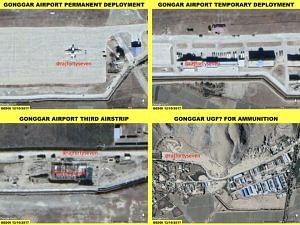
Shigatse Airbase
In August 2017, a lone UAV, probably a Winglong 1, was observed. Later, only Soar Dragons were observed at this airbase. These suggest that the medium-altitude long endurance or MALE UAV could not be operated successfully possibly due to harsh atmosphere and hence, a high-altitude long endurance or HALE UAV was operated successfully.
The Shigatse airport has recently been converted into an airbase, making it out of bounds for all civil flights. Construction of an additional airstrip is in progress on the western side of the main airstrip, likely to be used for UAV operations.
There are nine new aprons and eight new helipads recently constructed on the airbase, one of the satellite images suggests. The support buildings are used for accommodations of the staff.
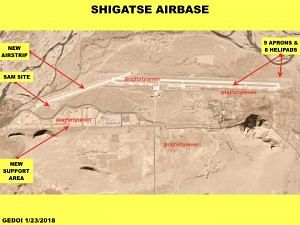
Qamdo Bamda Airport
The Bamda airport was upgraded with a longer runway last year. But after the Doklam stand-off, another airstrip has been added to its eastern side. The additional airstrip would give this airport capability to take off and land aircraft in tandem.
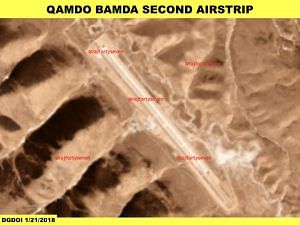
Nyingchi Airport
The Nyingchi airport apron and lounge have been extended along with provision of four jet bridges. This suggests that Nyingchi is preparing for heavier traffic in the coming days. An additional aviation fuel point has been constructed with two large storage tanks.
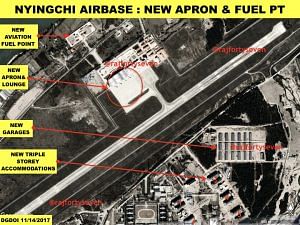
New Heliports
Three new heliports have been constructed in Tibet recently. The Lhasa and Ngari (Shiquanhe) heliports have come up last year. Some construction activity has been observed at the Cona township. But it is difficult to assess the exact size and shape due to lack of high-resolution images.
These heliports can accommodate a light helicopter (LH) regiment easily. Two of the heliports at Nyingchi and Cona have been built over the British-era helipads.
